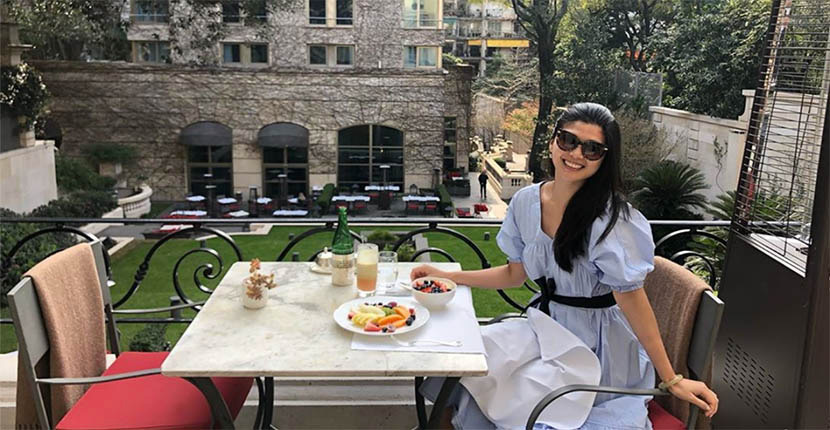
Jewelry influencer Christine Cheng enjoying breakfast in Buenos Aires. Photo via Instagram @christinechengny
Jewelry News
Jewelry Influencer: Get to Know Christine Cheng
The Gallery Director at Simon Teakle is a must follow Instagram account
If you’re an estate jewelry enthusiast and spend any amount of time on Instagram, chances are you’ve fallen into the magnetic pull of Christine Cheng’s stories. They’re one of the most enticing ways to while away spare moments and — rare for Instagram — come away enlightened rather than feeling you’ve lost ten minutes of your life. As Gallery Director of acclaimed jewelry dealer Simon Teakle, Cheng is constantly bouncing between auctions, fairs, and Teakle’s boutique, getting hands-on with the most lust-worthy treasures. And, lucky for us voyeurs, her Instagram followers get a front row seat for all the fun.
But Cheng isn’t your standard, singularly-focused jewelry influencer. More than just dazzling eye candy, she illuminates the history and cultural context around her favorite baubles, synthesizing references from art to film to architecture, and makes a case for their relevance today. From an ode to the pendeloque to the allure of paste, Cheng makes potentially dusty jewelry minutiae fresh, fashionable, and even cool. Read on to find out more about Christine and her world of bright, shiny things.
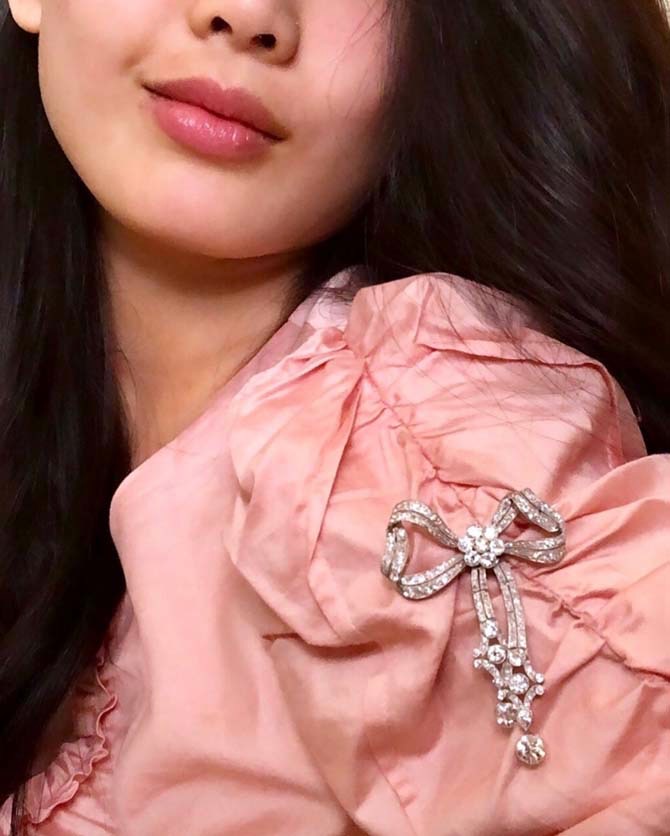
Christine Cheng wearing a vintage diamond ribbon brooch from Simon Teakle. Photo via Instagram @christinechengny
How did you get into the jewelry world?
I wanted to go to school for fashion but my dad made a deal with me: if I studied business undergrad, I could do whatever I wanted afterward. I went to Wharton and studied finance and marketing. After that, I moved to New York and wound up in the jewelry department at Vogue. All I knew was that I wanted to work at Vogue and it just so happened that it was the jewelry department that had an opening.
I was helping pull jewelry for shoots and it really honed my eye for storytelling, figuring out what jewelry would make sense for any given story. Unlike fashion, where the editor or stylist requests the specific looks they want, jewelry requires a wider array of options. It taught me to look at the bigger picture and overall mood rather than just what’s written in the concept brief.

Christine Cheng wearing Verdura jewels from Simon Teakle. Photo via Instagram @christinechengny
How did you wind up at Simon Teakle?
After Vogue, I went through a series of fashion communications jobs — at other magazines and doing PR for different fashion and jewelry brands. I decided to go to Paris for my MBA in Luxury Brand Management and thought I was going to stay there and work for a Richemont or LVMH house. But at the end of the day, I couldn’t stay away from New York.
I was back working in fashion PR and Simon actually found me on LinkedIn [laughs]. He searched “New York+Luxury+Jewelry” and found me. I was about to go to Paris for Fashion Week and really debating what to do. Eventually I was just like, there’ll always be another Fashion Week but the opportunity to learn from Simon Teakle, former head of jewelry at Christie’s, was something I couldn’t pass up.
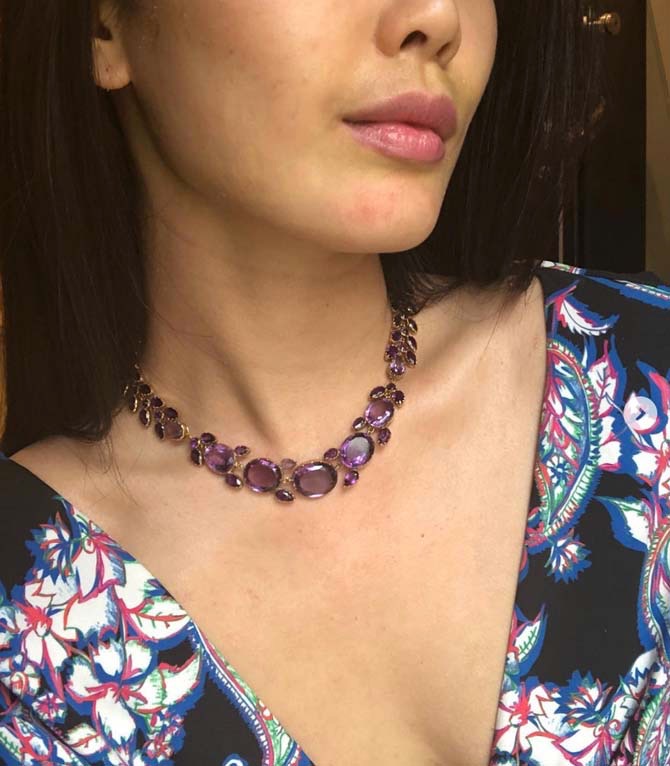
Christine Cheng wearing a Georgian amethyst necklace from Simon Teakle. Photo via Instagram @christinechengny
What do you in your job with Simon?
Everything! [Laughs] I’m sales, logistics, marketing, web, accounting, legal, a buyer — that’s what I love about it, I get to see everything in the business. My official title is Gallery Director. We have a store in Greenwich [Connecticut] so my average day begins with setting up the shop, listening to voicemails — we have a number of older clients so voicemail is still important! — and checking emails and DM’s for any enquiries or requests. I’ll meet with clients who want to buy or sell, jewelry and stone dealers who come to show us goods.
In between, I’ll work on administrative stuff and maybe tell a story on Instagram. I try to do at least one post a day for Simon’s Instagram, though he really controls it. I just take the picture; all the words are his. He has 40+ years of experience and is so knowledgeable, I don’t want to filter that, grammatical errors and all. I think people can really tell when something is in a person’s authentic voice versus a caption written by their social media manager.
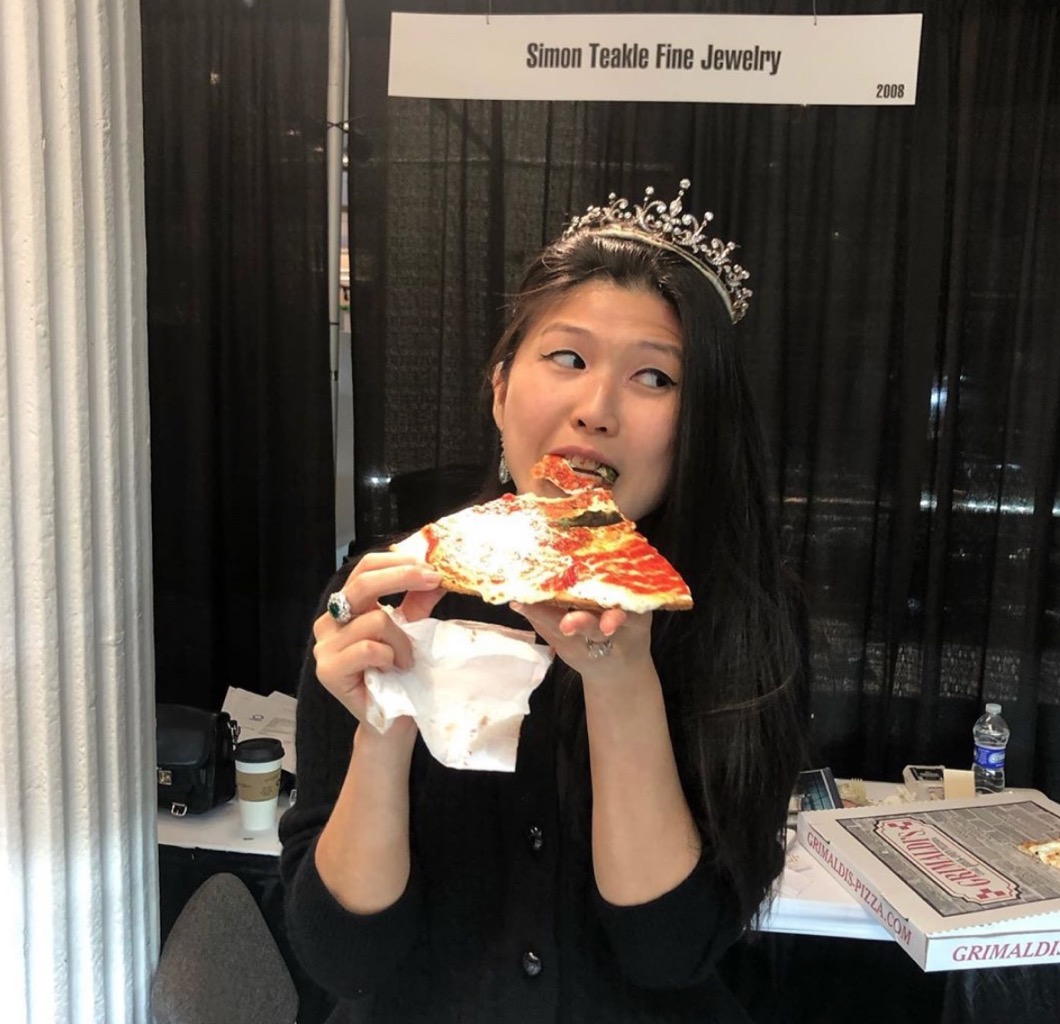
Christine Cheng wearing a tiara from Humphrey Butler Ltd. at the Antiques Show in New York. Photo via Instagram @christinechengny
Your Instagram is pure jewelry catnip, especially your stories. I love that they’re usually deep dives into specific topics. How do you decide what to get into?
They usually begin with what’s in my inventory at the store and what’s on my calendar. And I’m not talking National Pancake Day…like, is TEFAF coming up? What’s the sale at Christie’s? Do I have any similar pieces? Did I hear a talk on royal jewels and happen to have a few royal jewels I’m selling? I was at Giverny over the summer and that prompted me to do a story on all the floral jewels I had in the shop and the floral jewels that have stood out throughout history. It’s very much a reflection of what’s going on in my own life: what I’m seeing, where I’m going, what’s inspiring me. It’s all very selfish and personal [laughs].
But they’re often much more than just inspiration shots, they’re very educational.
Part of my job is to get clients to take risks, to be adventurous with jewelry and consider things that maybe they hadn’t before. And also, to be curious about the history behind what they’re buying and why it is significant. That’s what I try to do with my Instagram stories: show where this motif began, how it was worn, how it has endured over the ages, and how to wear it today. Basically, just showing how these pieces are so timeless and universal.

Christine Cheng trying on the Beats Pro Headphones decorated with diamonds by Graff at Christie’s. Photo via Instagram @christinechengny
I love all the references images you include, of things that aren’t just pictures of jewelry. How do you compile them?
I think we’re all sponges from day one — of everything you’ve seen, places you’ve been, books and magazines you’ve read, films you’ve seen. A lot of it comes from my saved folder on Instagram or just saved in my head and I have to track down images on Google. That’s the time-consuming part…just try Googling “Japanese Man with Pearl+Sartorialist”.
Generally, I just try to think of iconic moments that are relevant to whatever the topic is. Say it’s rubies, I think of all the iconic red imagery I can: textures from food, fashion, nature, art. Even if you’re a prolific jewelry collector, you’re not only buying jewelry. You’re dressing yourself, traveling, eating, reading, watch TV. So, I try to connect jewelry to all those other facets of culture.
How long does it usually take you to make a story?
You don’t want to know! It’s not just sourcing images but doing the research to write informative copy, figuring out a sequence that makes sense and is visually pleasing, what your transitions are. I want to tell a story as you would in a magazine: build a mood, make your case and conclude with some big finale you can buy. I like to always have it rooted in history but, presumably, if you’re buying jewelry you want to wear it. So, part of what I also try to do is give styling ideas. You know, how do you make this 18th century brooch work in 2019?
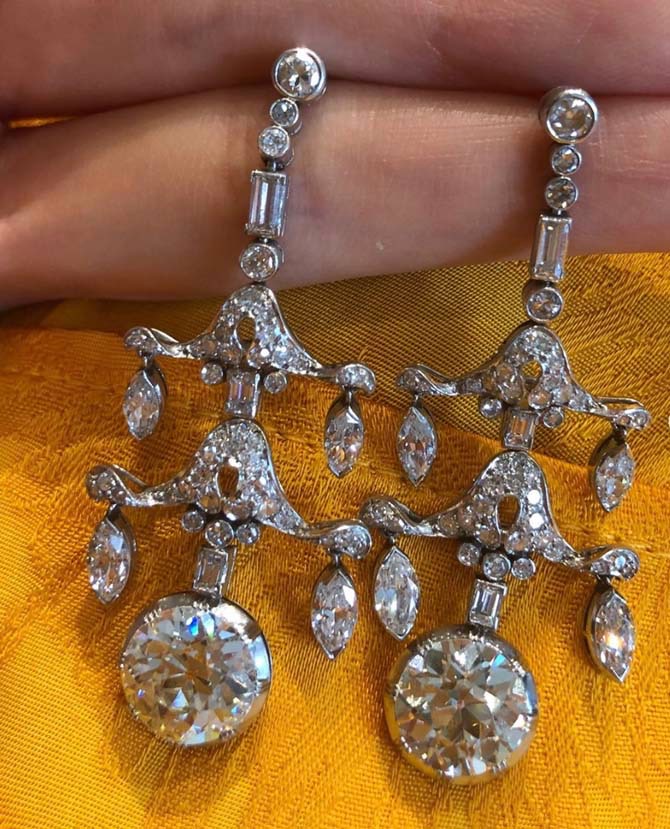
Christine showing her followers some Art Deco diamond earrings at Simon Teakle. Photo via Instagram @christinechengny
Do you find that Instagram is a valuable sales tool?
I think Instagram is very important because we have a global audience. I may not be the best at hashtags, but I do find that when I post things that are especially fabulous, it reaches people who weren’t previously following us and wind up reaching out. I’ve sold an important bracelet, sight unseen, to a client in Copenhagen. I sell to a lot of our international clients via Instagram. Personally, I prefer to see something being worn…you get the scale, the movement, the actual color. That’s why I usually show pieces on me in motion: to show how well the necklaces lays, how the earrings are articulated, to demonstrate the craftsmanship.
Looking at your Instagram, you’re often jet-setting around the world to fairs and trade shows. Do you have a favorite story of traveling in search of jewels?
Well, one of my favorite things is a tradition Simon and I have when we’re in London to exhibit at Masterpiece. On the first Saturday of the fair, we spend the morning at Portobello Road Market, which has lots of antiques beyond jewelry. We get there at 7am as the dealers are arriving from the countryside and setting up their wares. It’s very funny — we’re all dressed up for the fair, out on the street haggling it out before heading straight to opening our booth at Masterpiece.
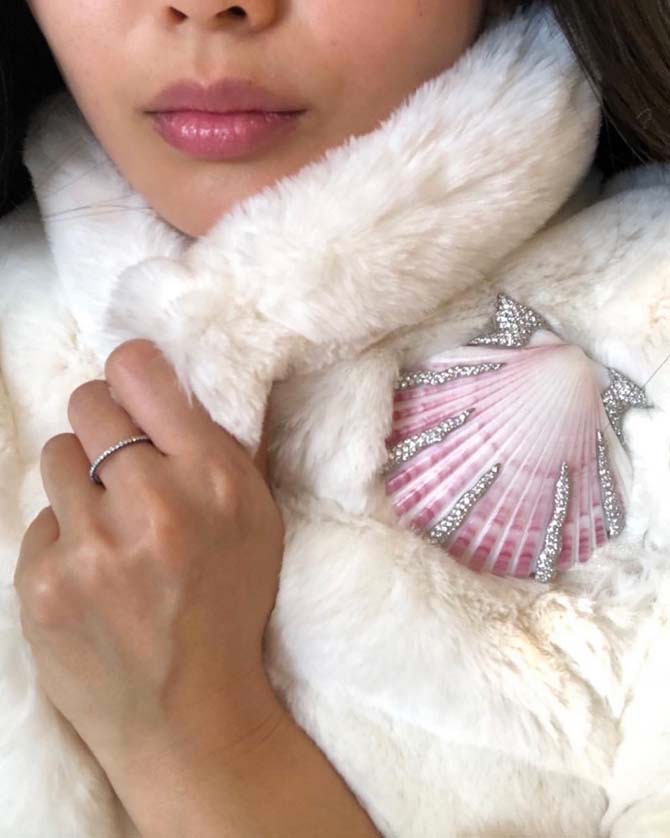
Christine Cheng bundled up in a Taffin ring and Verdura shell from Simon Teakle. Photo via Instagram @christinechengny
What are some vintage styles you’re loving right now?
I’m loving what I call “pretty girl jewelry”. It’s a great match for this prairie/Victoriana moment fashion’s having…you know, Brock Collection, Markarian. The open necklines are nice for Victorian and Belle Epoque fringe and swag necklaces. I also think people are more attracted to casual fashion, streetwear and all that, and chunky yellow gold is the easiest way to wear estate jewelry casually. 90’s minimalism is also coming back so things with clean lines, basically anything Art Deco, feels very right for right now. And the beauty of minimalist fashion is that it’s a great blank canvas for any jewelry!
What advice do you have for young people, like yourself, who may be interested in starting a collection but aren’t sure where to begin? What are some good starter pieces?
As with anything, you have to buy what you love. Once you have an idea of an era or look you’re into, you can buy into it with pieces that have less precious materials. I can’t afford a pair of Georgian diamond girandoles but I probably can afford a pair of Georgian paste girandoles. People have been doing the “look for less” for centuries — that’s why there are all these amethyst parures, because the diamonds were taken out and replaced with a less expensive alternative. The craftsmanship is just as fine regardless of the materials.
Go for stones and materials that are more accessible: paste, Berlin iron, garnets instead of rubies, peridots. And don’t shy away from unsigned — you can find pieces with just as much character and impact as Cartier and Van Cleef without the premium that comes with the name.
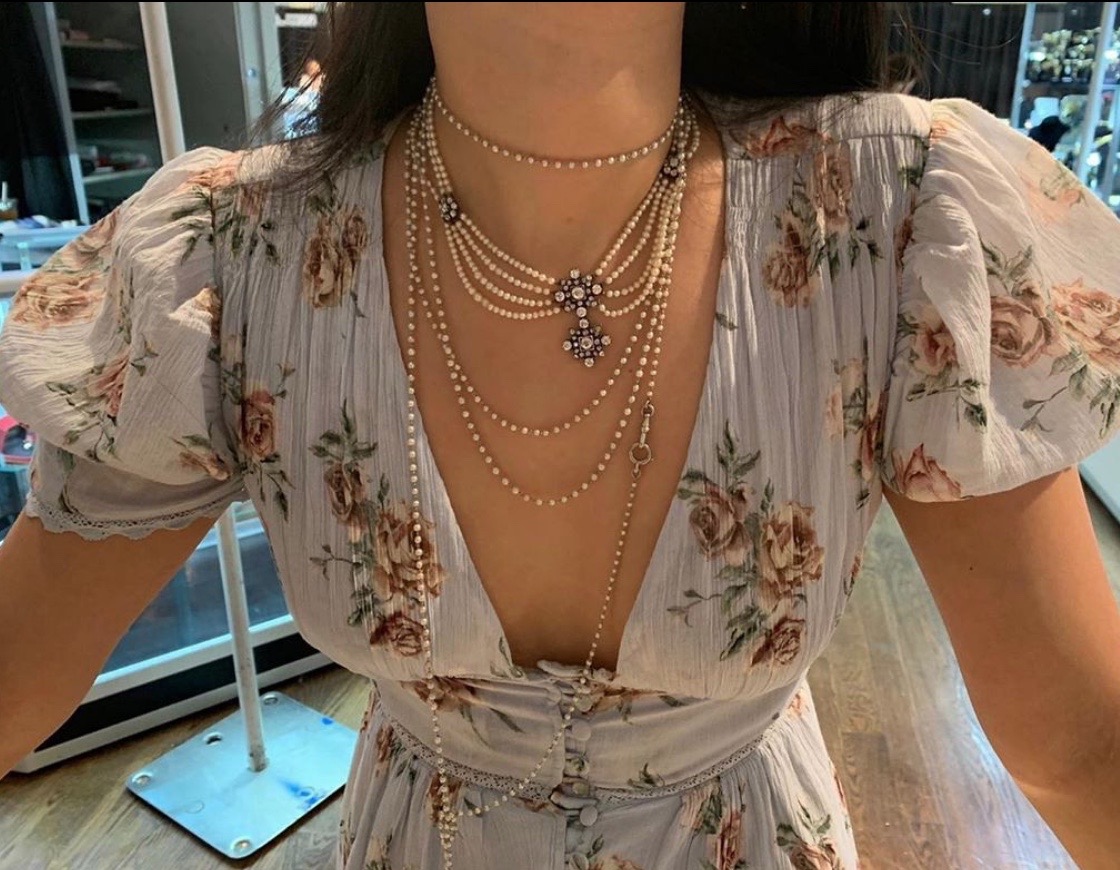
Christine Cheng wearing ropes of pearls at an Antiques Show. Photo via Instagram @christinechengny
You have very diverse taste in jewelry. How would you describe your style?
I’d say elegance with a wink. I like very classic glamour but with something unexpected, some irreverence. And, as much as I think all these little delicate things are pretty, I like jewelry you can see…something substantial. I love jewelry, I wanna SEE it!
Related Stories:
Shop The Hottest Jewelry Trends For The Holidays
The Gold Wreath of a New York Suffragist
Jewelry Influencer: Get to Know Lynn Yaeger
Get a gem in your mailbox SIGN UP FOR THE ADVENTURINE NEWSLETTER




